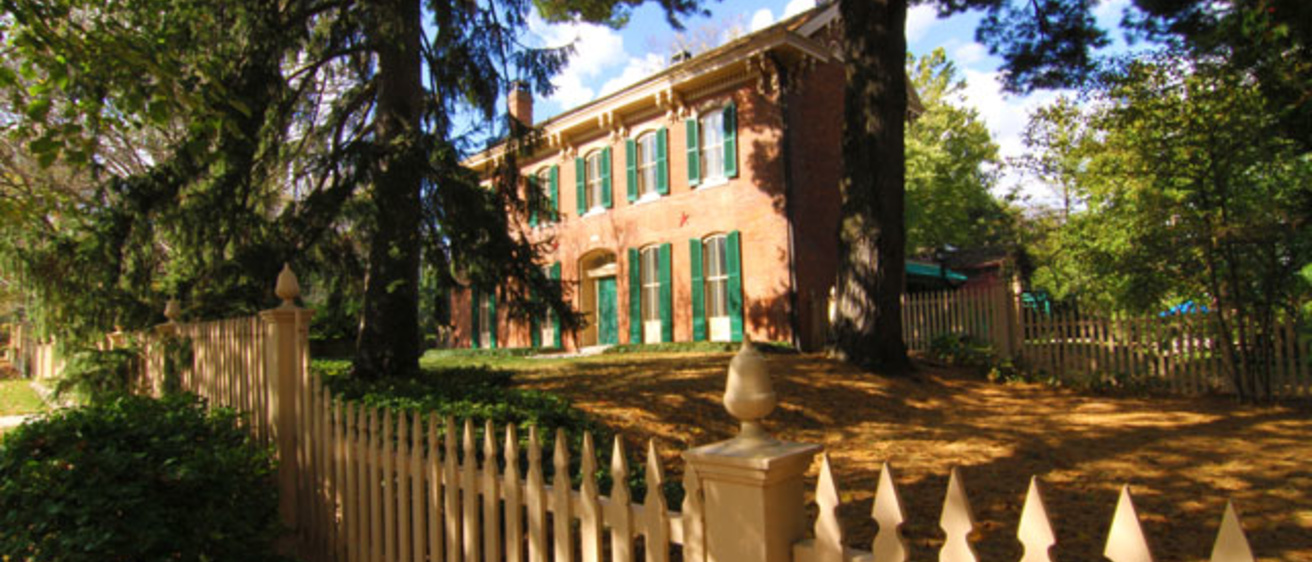The Grant Wood Symposium is just one aspect of a grander vision—an artist colony that will be a lasting legacy of the creativity of Iowa's most famous artist and his commitment to supporting other artists.
Wood was born near Anamosa and also lived in Cedar Rapids while growing up, so his roots were solidly in Iowa. After studying at the Art Institute of Chicago and traveling repeatedly to Europe, he resettled in his home state to teach and work in the Cedar Rapids schools, and eventually he became one of the leading proponents of American Regionalism. And in the depths of the Depression he founded the Stone City Art Colony in 1931, before joining the faculty of the University of Iowa in 1934.
Wood's commitment to the support of other artists, exemplified by the Stone City Art Colony, has been reinvigorated at the UI with the creation of the Grant Wood Colony. The home for this initiative is the neighborhood where he lived during his UI tenure; the awarding of two post-doctoral fellowships—one in painting and one in printmaking—and the sponsorship of the Grant Wood Symposium are its first evidences.
The mission of the colony is to nurture creative work and teaching in disciplines relevant to Wood's life and work—studio art and art history, and eventually expanding to a variety of disciplines. The long-term goal is to create a vibrant colony and cultural center, woven together by gardens and studio space.
Grant Wood Symposium
The University of Iowa will celebrate Iowa's most famous artist and faculty member, Grant Wood, with the Grant Wood Biennial Symposium,Grant Wood Today, Friday-Saturday, April 13-14, in Art Building West and the Black Box Theater of the Iowa Memorial Union. A full schedule of the free symposium is available at www.art.uiowa.edu/gw_symposium.html.
Learn more about the symposium and the Grant Wood Art Colony fellowships at www.art.uiowa.edu/gw_main.html.
And later this week...
Meet the first two Grant Wood Fellowship recipients. An audio slide show will be published on Iowa Now between now and the Grant Wood Biennial Symposium.
"Our goal is to expand the colony and fellowship program to include seven artists, performers, writers, and humanists on yearlong creative and teaching fellowships," explains John Beldon Scott, director of the School of Art and Art History in the College of Liberal Arts and Sciences. "The idea is to encompass practitioners of media and disciplines that were of interest to Grant Wood such as poetry, creative writing, theatre, history, and literature, as well as the visual arts.
"These fellows will reside in the cluster of houses adjacent to the Grant Wood House in Iowa City that will form an arts community in a garden setting, with nearby studios and the Grant Wood House at its center.
"Taking its inspiration from the Stone City Art Colony Grant Wood sponsored in the summers of 1932 and 1933, the Grant Wood Arts Colony will become a permanent living legacy of the vision for the promotion of contemporary art Iowa’s famed painter formulated just at the time the University of Iowa was beginning to establish its reputation as a leader in the field of creative practice in the arts."
The new colony has been made possible by the generosity of Iowa City attorney James Hayes, who has lived in the Grant Wood house on Court Street for many years, and then started acquiring adjacent properties on Burlington Street.
As he lived in the house, his appreciation of Wood and his commitment to honoring him grew.
"I became more intrigued as every year went on with the breadth of his artistic ability," he says. "Not just painting and lithography, but wood and stone and metal. For many years every time I'd turn around I would find something new that he had done to the house or to the property. He laid stone walls, and did reconstruction himself. I would find on the walls his handwritten messages to the workers."
Eventually he decided that the house should become the possession of the university as a permanent remembrance of Wood's time at the UI: "When the university and I were first talking about my gift of the house as a cultural center I thought it would be cool if the houses in back could be used for visiting artists. I wasn't thinking of anything formal at the time.
"But about two years ago I added a fourth house on Burlington Street, and I was talking to Doug True, the vice president for finance, and John Beldon Scott about the more general idea of artists living in those houses, and John said something to the effect of, wouldn't it be great to have Grant Wood artists use the place? And Doug said, why don't we do it right now? So that was the beginning, and we came up with the concept of a Grant Wood Art Colony."
Hayes explains that he foresees all the buildings on Burlington Street serving as both residences and studio spaces. "The plan is that those four houses will all be occupied with fellows. The hope is that down the road there will be additional studios. By the time the university takes over, that will all become one property."
The Grant Wood house itself will be a place in reserve for visiting guests of the university and a meeting space. "It's a great place for receptions, especially in the summertime," Hayes says. "We have already put together some notebooks about how people will go about requesting use of the house.
"I think this will be a great thing for the School of Art and Art History, but also for the university as a whole, the city of Iowa City, the state of Iowa... and the neighborhood. Grant Wood is so well known, and finally there is a fitting memorial.
"It's very refreshing and satisfying that the university is taking this on now, when there is a Grant Wood renaissance. His staying power says something about what a great artist he was."
